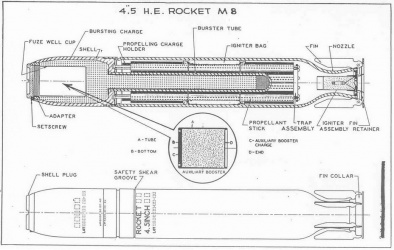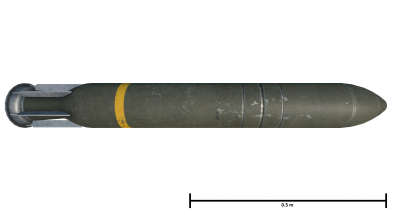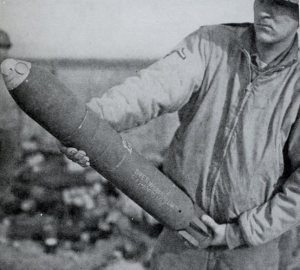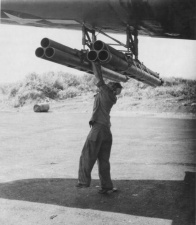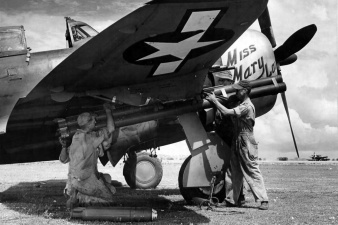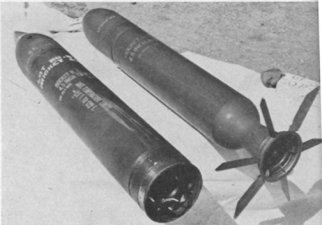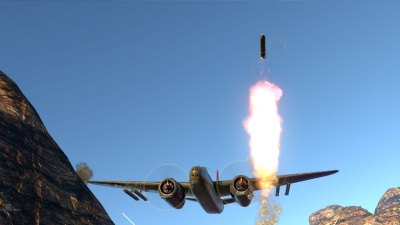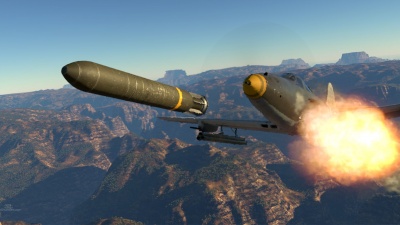Difference between revisions of "M8"
(Created page.) |
U109472964 (talk | contribs) (→History: Wrote History for the M8 Rocket) (Tag: Visual edit) |
||
| (21 intermediate revisions by 8 users not shown) | |||
| Line 1: | Line 1: | ||
| − | {{ | + | [[File:4.5_in_M8_rocket_diagram.jpg|thumbnail|right|x250px|]] |
| + | {{About | ||
| + | | about = American-made rocket '''{{PAGENAME}}''' | ||
| + | |usage = other uses | ||
| + | |link = M8 (Disambiguation) | ||
| + | }} | ||
| + | == Description == | ||
| + | <!-- ''Write an introduction to the article in 2-3 small paragraphs. Briefly tell us about the history of the development and combat using the weaponry and also about its features. Compile a list of air, ground, or naval vehicles that feature this weapon system in the game.'' --> | ||
| + | [[File:WeaponImage M8.png|thumb|left|420px|The M8 rocket (scale is approximate)]] | ||
| + | [[File:M8_rocket_sideview.jpg|520px|thumb|right|Side view of an '''{{PAGENAME}}''' 4.75 inch unguided rocket.]] | ||
| + | {{break}} | ||
| + | The 4.5-inch (114 mm) '''{{PAGENAME}}''' fin-stabilised rocket is approximately 33 in (0.83 m) in length and 40 lb (18.1 kg) and is almost an equivalent of a 105 mm Shell M1. This rocket utilises an M4 fuse which explodes after a 0.015-sec delay set off by auxiliary M1 booster. | ||
| + | |||
| + | The components of the rocket break down into three separate sections, the fuse, shell and motor body. The shell of the rocket or the head is made up of a warhead body fitted with a burster tube. The burster tube itself extends from the shell through the rocket body and through the rocket motor, the purpose of this is to expand the explosive capability of the rocket by utilising the rocket motor as an additional source of fragmentation in the explosion. Once fired, folding fins around the tail flange will extend and spin-stabilise the rocket. | ||
| + | |||
| + | The M8 rocket requires a tube launcher to launch (as opposed to being installed directly to external hardpoints) and this is accomplished by mounting an M10 cluster launcher to the underside of the aircraft's wings or fuselage belly. The M10 is a cluster of three 10-foot tubes manufactured from plastic (M14s are made from steel and M15s are constructed of magnesium alloy) and are banded together in six places and are secured to the aircraft via two mounting straps, front and rear. The rear strap also bears the electrical connections which link up to the rockets once in the tubes as the firing links. The release and contact mechanisms are protected from flying links and fired casings ejected from the wing guns to prevent accidental damage or drop release of the M10 launcher. | ||
| − | |||
| − | |||
| − | |||
=== Vehicles equipped with this weapon === | === Vehicles equipped with this weapon === | ||
| − | '' | + | <!-- ''List out vehicles that are equipped with the weapon.'' --> |
| + | |||
| + | {{Navigation-Start|Vehicles equipped with this weapon}} | ||
| + | |||
| + | {{Navigation-First-Line|'''Fighters'''}} | ||
| + | {{Navigation-Line|P-39}}{{Specs-Link|p-39n}}{{-}}{{Specs-Link|p-39q_5}} | ||
| + | {{Navigation-Line|P-47}}{{Specs-Link|p-47d_22_re}}{{-}}{{Specs-Link|thunderbolt_mk1}}{{-}}{{Specs-Link|p-47d-28}} | ||
| + | {{Navigation-Line|P-51D}}{{Specs-Link|p-51d-5}}{{-}}{{Specs-Link|p-51d-10}}{{-}}{{Specs-Link|p-51d-20_china}}{{-}}{{Specs-Link|p-51d-20-na}}{{-}}{{Specs-Link|p-51d-30_usaaf_korea}}{{-}}{{Specs-Link|p-51h-5_na}}{{-}}{{Specs-Link|p-51k}} | ||
| + | |||
| + | {{Navigation-First-Line|'''Twin-engine fighters'''}}{{Specs-Link|p-38g}}{{-}}{{Specs-Link|p-38g_metal}}{{-}}{{Specs-Link|p-38j}}{{-}}{{Specs-Link|p-38j_marge}} | ||
| + | |||
| + | {{Navigation-First-Line|'''Strike aircraft'''}}{{Specs-Link|a-20g}} | ||
| + | |||
| + | {{Navigation-First-Line|'''Medium tanks'''}}{{Specs-Link|us_m4_sherman_calliope}}{{-}}{{Specs-Link|us_m26_t99}} | ||
| + | |||
| + | {{Navigation-End}} | ||
== General info == | == General info == | ||
| − | ''Tell us about the tactical and technical characteristics of the | + | <!-- ''Tell us about the tactical and technical characteristics of the rocket.'' --> |
| + | [[File:M8_4.5in_fin_stabilized_rocket.png|300px|thumb|right|A soldier holding an '''{{PAGENAME}}''' rocket prior to loading in a launch tube.]] | ||
| + | {| class="wikitable" style="text-align:center" | ||
| + | ! colspan="2" | Rocket characteristics | ||
| + | |- | ||
| + | | '''Mass''' || 17 kg | ||
| + | |- | ||
| + | | '''Maximum speed''' || 260 m/s | ||
| + | |- | ||
| + | | '''Explosive mass''' || 1.95 kg TNTeq | ||
| + | |- | ||
| + | | '''Warhead type''' || HE | ||
| + | |- | ||
| + | |} | ||
=== Effective damage === | === Effective damage === | ||
| − | ''Describe the type of damage produced by this type of | + | <!-- ''Describe the type of damage produced by this type of rocket (high explosive, splash damage, etc)'' --> |
| + | After slamming into a target a slight delay will set off the explosive mass of the missile, causing the TNT shell to detonate along with fragmenting the rocket body and motor. Damage is caused by both the high explosive and fragmentation. | ||
=== Comparison with analogues === | === Comparison with analogues === | ||
| − | ''Give a comparative description of | + | ''Give a comparative description of rockets that have firepower equal to this weapon.'' |
| − | == Usage in | + | == Usage in battles == |
| − | ''Describe situations when you would | + | <!-- ''Describe situations when you would utilise this rocket in-game (vehicle, pillbox, base, etc)'' --> |
| + | The M8 rockets are typically mounted on an aircraft in groups of three (usually two launchers of three). The M8 rocket is typically best utilised against personnel, installations and light armoured vehicles due to the fantastic fragmentation of this rocket upon impact and explosion. | ||
=== Pros and cons === | === Pros and cons === | ||
| − | '' | + | <!-- ''Summarise and briefly evaluate the weaponry in terms of its characteristics and combat effectiveness. Mark pros and cons as a list.'' --> |
'''Pros:''' | '''Pros:''' | ||
| − | * | + | |
| + | * Lightweight, able to mount on fighter aircraft | ||
| + | * Can be used against bombers | ||
'''Cons:''' | '''Cons:''' | ||
| − | |||
| − | == | + | * Inaccurate, best fired in groups to increase the chance of hitting a target |
| − | + | * Increases aerodynamic drag, decreasing flight efficiency | |
| + | |||
| + | == History == | ||
| + | The American M8 Rocket, known as the "M8 Rocket Launcher," is a significant chapter in the history of World War II artillery. It was developed during the early 1940s to address the need for a versatile and mobile ground-based rocket artillery system. The M8 Rocket Launcher's design featured a truck-mounted launch platform equipped with multiple launch tubes capable of firing 4.5-inch M8 rockets, which were often colloquially referred to as "Calliope" rockets. This system was developed to provide rapid and concentrated firepower on the battlefield. | ||
| + | |||
| + | One of the standout features of the M8 Rocket Launcher was its adaptability. It could be mounted on a variety of vehicles, most notably the Sherman tank, leading to the creation of the "Sherman Calliope." This configuration enabled armored units to deliver devastating indirect fire support while remaining mobile, a significant advantage in dynamic warfare. The M8 rocket system was instrumental in the development of barrage fire tactics, involving the rapid launching of multiple rockets to saturate a specific area with explosive firepower. | ||
| + | The M8 Rocket Launcher had a profound impact on the course of World War II, especially for American and Allied forces. It played a pivotal role in critical campaigns such as the Normandy landings (D-Day), where it provided essential fire support for the assault troops. The sight and sound of M8 rockets firing was not only intimidating but also highly effective in supporting ground forces during the intense combat of World War II. After the war, as military technology advanced, the M8 Rocket Launcher was gradually phased out in favor of more sophisticated rocket artillery systems. | ||
== Media == | == Media == | ||
| − | '' | + | <!-- ''Excellent additions to the article would be video guides, screenshots from the game, and photos.'' --> |
| + | |||
| + | ;Images | ||
| + | <gallery mode="packed-hover" heights="150"> | ||
| + | File:A-20_4.5in-M8rockets.jpg|<small>Image of ground crew member adjusting M8 rocket launch tubes under the wing of an [[A-20G-25]].</small> | ||
| + | File:P-47D_with_bazooka_rocket_tubes.jpg|<small>Crew members loading M8 rocket tubes under the wing of an [[P-47 (Family)|P-47D]] in Saipan, 1944.</small> | ||
| + | File:M8_fins_out.png|<small>An M8 rocket with its stabilising fins out (right) and an M16 rocket (left).</small> | ||
| + | File:A-20G-25_firingoff_M8.jpg|<small>An [[A-20G-25]] firing off an M8 rocket from an M10 Bazooka tube launcher.</small> | ||
| + | File:P-39Q-5_firingoff_M8.jpg|<small>A [[P-39Q-5]] firing off an M8 rocket from an underwing M10 Bazooka tube launcher.</small> | ||
| + | </gallery> | ||
| + | |||
| + | == See also == | ||
| + | ''Links to the articles on the War Thunder Wiki that you think will be useful for the reader, for example:'' | ||
| − | + | * ''reference to the article about the variant of the weapon;'' | |
| − | |||
| − | * ''reference to the article about the variant of the | ||
* ''references to approximate analogues by other nations and research trees.'' | * ''references to approximate analogues by other nations and research trees.'' | ||
| − | |||
| − | == | + | == External links == |
| − | ''Paste links to sources and external resources, such as:'' | + | <!-- ''Paste links to sources and external resources, such as:'' |
| − | * ''topic on the official game forum'' | + | * ''topic on the official game forum;'' |
| − | * '' | + | * ''other literature.'' --> |
| − | * | + | |
| − | * | + | * [http://bulletpicker.com/pdf/USNBD%20-%20US%20Rockets%20and%20Fuzes.pdf US Rockets and Fuzes - United States Navy Bomb Disposal Manual, 15 May 1945, pg. 14] |
| + | * [https://sill-www.army.mil/firesbulletin/archives/1946/OCT_1946/OCT_1946_FULL_EDITION.pdf Hedekin, Thomas B., The Field Artillery Journal, October 1946, Volume 36, No. 10, page 568] | ||
| + | * [http://bulletpicker.com/pdf/OS%209-69,%20Rockets%20and%20Launchers,%20All%20Types.pdf OS-9-69 Rockets and Launchers, All Types, The Ordnance School - Aberdeen Proving Ground, Maryland, February 1944, pages 65, 67 and 68.] | ||
| + | * [https://forum.warthunder.com/index.php?/topic/450684-m8-rocket-performance-error/ War Thunder Forum Bug Report: M8 Rocket Performance Error] | ||
| + | * [[wikipedia:M8_(rocket)|Wikipedia - M8 (rocket)]] | ||
| − | {{ | + | {{Rockets}} |
| − | [[Category: | + | [[Category:Suspended armaments]] |
Latest revision as of 21:57, 19 October 2023
| This page is about the American-made rocket M8. For other uses, see M8 (Disambiguation). |
Contents
Description
The 4.5-inch (114 mm) M8 fin-stabilised rocket is approximately 33 in (0.83 m) in length and 40 lb (18.1 kg) and is almost an equivalent of a 105 mm Shell M1. This rocket utilises an M4 fuse which explodes after a 0.015-sec delay set off by auxiliary M1 booster.
The components of the rocket break down into three separate sections, the fuse, shell and motor body. The shell of the rocket or the head is made up of a warhead body fitted with a burster tube. The burster tube itself extends from the shell through the rocket body and through the rocket motor, the purpose of this is to expand the explosive capability of the rocket by utilising the rocket motor as an additional source of fragmentation in the explosion. Once fired, folding fins around the tail flange will extend and spin-stabilise the rocket.
The M8 rocket requires a tube launcher to launch (as opposed to being installed directly to external hardpoints) and this is accomplished by mounting an M10 cluster launcher to the underside of the aircraft's wings or fuselage belly. The M10 is a cluster of three 10-foot tubes manufactured from plastic (M14s are made from steel and M15s are constructed of magnesium alloy) and are banded together in six places and are secured to the aircraft via two mounting straps, front and rear. The rear strap also bears the electrical connections which link up to the rockets once in the tubes as the firing links. The release and contact mechanisms are protected from flying links and fired casings ejected from the wing guns to prevent accidental damage or drop release of the M10 launcher.
Vehicles equipped with this weapon
| Vehicles equipped with this weapon | |
|---|---|
| Fighters | |
| P-39 | P-39N-0 · P-39Q-5 |
| P-47 | P-47D-22-RE · ▄Thunderbolt Mk.1 · P-47D-28 |
| P-51D | P-51D-5 · P-51D-10 · ␗P-51D-20 · P-51D-20-NA · P-51D-30 · P-51H-5-NA · ␗P-51K |
| Twin-engine fighters | P-38G-1 · XP-38G · P-38J-15 · Bong's P-38J-15 |
| Strike aircraft | A-20G-25 |
| Medium tanks | Calliope · M26 T99 |
General info
| Rocket characteristics | |
|---|---|
| Mass | 17 kg |
| Maximum speed | 260 m/s |
| Explosive mass | 1.95 kg TNTeq |
| Warhead type | HE |
Effective damage
After slamming into a target a slight delay will set off the explosive mass of the missile, causing the TNT shell to detonate along with fragmenting the rocket body and motor. Damage is caused by both the high explosive and fragmentation.
Comparison with analogues
Give a comparative description of rockets that have firepower equal to this weapon.
Usage in battles
The M8 rockets are typically mounted on an aircraft in groups of three (usually two launchers of three). The M8 rocket is typically best utilised against personnel, installations and light armoured vehicles due to the fantastic fragmentation of this rocket upon impact and explosion.
Pros and cons
Pros:
- Lightweight, able to mount on fighter aircraft
- Can be used against bombers
Cons:
- Inaccurate, best fired in groups to increase the chance of hitting a target
- Increases aerodynamic drag, decreasing flight efficiency
History
The American M8 Rocket, known as the "M8 Rocket Launcher," is a significant chapter in the history of World War II artillery. It was developed during the early 1940s to address the need for a versatile and mobile ground-based rocket artillery system. The M8 Rocket Launcher's design featured a truck-mounted launch platform equipped with multiple launch tubes capable of firing 4.5-inch M8 rockets, which were often colloquially referred to as "Calliope" rockets. This system was developed to provide rapid and concentrated firepower on the battlefield.
One of the standout features of the M8 Rocket Launcher was its adaptability. It could be mounted on a variety of vehicles, most notably the Sherman tank, leading to the creation of the "Sherman Calliope." This configuration enabled armored units to deliver devastating indirect fire support while remaining mobile, a significant advantage in dynamic warfare. The M8 rocket system was instrumental in the development of barrage fire tactics, involving the rapid launching of multiple rockets to saturate a specific area with explosive firepower.
The M8 Rocket Launcher had a profound impact on the course of World War II, especially for American and Allied forces. It played a pivotal role in critical campaigns such as the Normandy landings (D-Day), where it provided essential fire support for the assault troops. The sight and sound of M8 rockets firing was not only intimidating but also highly effective in supporting ground forces during the intense combat of World War II. After the war, as military technology advanced, the M8 Rocket Launcher was gradually phased out in favor of more sophisticated rocket artillery systems.
Media
- Images
Image of ground crew member adjusting M8 rocket launch tubes under the wing of an A-20G-25.
Crew members loading M8 rocket tubes under the wing of an P-47D in Saipan, 1944.
An A-20G-25 firing off an M8 rocket from an M10 Bazooka tube launcher.
A P-39Q-5 firing off an M8 rocket from an underwing M10 Bazooka tube launcher.
See also
Links to the articles on the War Thunder Wiki that you think will be useful for the reader, for example:
- reference to the article about the variant of the weapon;
- references to approximate analogues by other nations and research trees.
External links
- US Rockets and Fuzes - United States Navy Bomb Disposal Manual, 15 May 1945, pg. 14
- Hedekin, Thomas B., The Field Artillery Journal, October 1946, Volume 36, No. 10, page 568
- OS-9-69 Rockets and Launchers, All Types, The Ordnance School - Aberdeen Proving Ground, Maryland, February 1944, pages 65, 67 and 68.
- War Thunder Forum Bug Report: M8 Rocket Performance Error
- Wikipedia - M8 (rocket)


